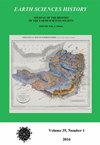乔治·贝拉斯·格林诺对英属印度的自然和地质特征的概述(1854年,1855年):它的生产,分布,变种和生存
IF 0.6
4区 哲学
Q4 GEOSCIENCES, MULTIDISCIPLINARY
引用次数: 0
摘要
格里诺的印度大型地质图(1854年)是印度地质制图史上的一个重要里程碑,是第一张完整印度次大陆的地质图。本文试图介绍这张开创性地图的生产、分布、变体和生存情况。地图上包含的地质信息几乎完全基于已公布的数据来源,格里诺从未访问过印度,但该地图远不止是一份汇编。它的建造需要绘制地形基准图,在大片未绘制地图的领土上进行地质插值,将主要的岩性描述组织成统一的年代地层顺序,并整合古生物学信息。按照现代标准,地图上的地层划分是不精确的,地层分辨率很低,结构数据完全缺乏,但它仍然是全印度唯一可用的地质图,直到大约24年后印度地质调查局制作出一张较小比例的地图。就面积覆盖率和缺乏可靠信息而言,格里诺的印度地图比他更著名的英格兰和威尔士地质地图更具雄心和开拓性。制作了202份地图,其中60份由东印度公司购买,另外40份左右由格里诺赠送给了各个公共机构和杰出的地质学家。爱德华·斯坦福于1855年获得了这幅地图的出版权,并继续提供副本出售,直到1898年。最近的一项调查确定了地图的三种变体状态,并自信地找到了34份幸存的副本。由于这里概述的原因,格里诺的印度地图自出版以来一直默默无闻。它应该更广为人知。本文章由计算机程序翻译,如有差异,请以英文原文为准。
GEORGE BELLAS GREENOUGH’S GENERAL SKETCH OF THE PHYSICAL AND GEOLOGICAL FEATURES OF BRITISH INDIA (1854, 1855): ITS PRODUCTION, DISTRIBUTION, VARIANTS AND SURVIVORSHIP
Greenough’s large-scale geological map of India (1854) represents a significant landmark in the history of geological cartography in India, it being the first geological map of the entire Indian sub-continent. This paper attempts to provide an account of the production, distribution, variants and survivorship of this pioneering map. The geological information contained on the map is based almost entirely on published data sources, Greenough never having visited India, yet the map is far more than a mere compilation. Its construction required the preparation of a topographic base map, geological interpolation over large swathes of unmapped territory, the organizing of mainly lithological descriptions into a unified chronostratigraphic order, and the integration of palaeontological information. By modern standards the delineation of strata on the map is imprecise, stratigraphic resolution is poor, and structural data are entirely lacking, yet it remained unrivalled as the only available geological map of all-India until the Geological Survey of India produced a smaller-scale map some twenty-four years later. In terms of areal coverage and paucity of reliable information, Greenough’s India map represents a far more ambitious and pioneering undertaking than his more famous geological map of England and Wales.
202 copies of the map were produced, sixty of which were purchased by the East India Company, while a further forty or so were gifted by Greenough to various public institutions and distinguished geologists. Edward Stanford acquired publishing rights to the map in 1855 and continued to offer copies for sale until at least 1898. A recent survey has identified three variant states of the map and has confidently located thirty-four surviving copies.
For reasons outlined here, Greenough’s India map has languished in obscurity since its publication. It deserves to be better known.
求助全文
通过发布文献求助,成功后即可免费获取论文全文。
去求助
来源期刊

Earth Sciences History
GEOSCIENCES, MULTIDISCIPLINARY-HISTORY & PHILOSOPHY OF SCIENCE
CiteScore
1.00
自引率
0.00%
发文量
1
审稿时长
>12 weeks
期刊介绍:
Earth Sciences History promotes and publishes historical work on all areas of the earth sciences – including geology, geography, geophysics, oceanography, paleontology, meteorology, and climatology.
The journal honors and encourages a variety of approaches to historical study: biography, history of ideas, social history, and histories of institutions, organizations, and techniques.
Articles are peer reviewed.
 求助内容:
求助内容: 应助结果提醒方式:
应助结果提醒方式:


